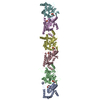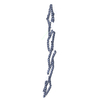[English] 日本語
 Yorodumi
Yorodumi- PDB-7m6j: Human Septin Hexameric Complex SEPT2G/SEPT6/SEPT7 by Single Parti... -
+ Open data
Open data
- Basic information
Basic information
| Entry | Database: PDB / ID: 7m6j | ||||||||||||
|---|---|---|---|---|---|---|---|---|---|---|---|---|---|
| Title | Human Septin Hexameric Complex SEPT2G/SEPT6/SEPT7 by Single Particle Cryo-EM | ||||||||||||
 Components Components |
| ||||||||||||
 Keywords Keywords |  CELL CYCLE / CELL CYCLE /  Complex / SPA / Complex / SPA /  Cytoskeleton Cytoskeleton | ||||||||||||
| Function / homology |  Function and homology information Function and homology informationseptin collar / regulation of embryonic cell shape / sperm annulus /  septin complex / positive regulation of non-motile cilium assembly / photoreceptor connecting cilium / septin complex / positive regulation of non-motile cilium assembly / photoreceptor connecting cilium /  septin ring / cytoskeleton-dependent cytokinesis / septin ring / cytoskeleton-dependent cytokinesis /  regulation of exocytosis / non-motile cilium ...septin collar / regulation of embryonic cell shape / sperm annulus / regulation of exocytosis / non-motile cilium ...septin collar / regulation of embryonic cell shape / sperm annulus /  septin complex / positive regulation of non-motile cilium assembly / photoreceptor connecting cilium / septin complex / positive regulation of non-motile cilium assembly / photoreceptor connecting cilium /  septin ring / cytoskeleton-dependent cytokinesis / septin ring / cytoskeleton-dependent cytokinesis /  regulation of exocytosis / non-motile cilium / ciliary membrane / smoothened signaling pathway / cell division site / regulation of exocytosis / non-motile cilium / ciliary membrane / smoothened signaling pathway / cell division site /  intercellular bridge / intercellular bridge /  axoneme / axoneme /  cleavage furrow / mitotic cytokinesis / cleavage furrow / mitotic cytokinesis /  cilium assembly / axon terminus / cilium assembly / axon terminus /  stress fiber / Anchoring of the basal body to the plasma membrane / MAPK6/MAPK4 signaling / stress fiber / Anchoring of the basal body to the plasma membrane / MAPK6/MAPK4 signaling /  kinetochore / spindle / microtubule cytoskeleton / kinetochore / spindle / microtubule cytoskeleton /  synaptic vesicle / synaptic vesicle /  actin cytoskeleton / midbody / actin cytoskeleton / midbody /  spermatogenesis / spermatogenesis /  cell differentiation / molecular adaptor activity / cell differentiation / molecular adaptor activity /  cadherin binding / cadherin binding /  GTPase activity / GTP binding / structural molecule activity / extracellular exosome / GTPase activity / GTP binding / structural molecule activity / extracellular exosome /  nucleoplasm / identical protein binding / nucleoplasm / identical protein binding /  nucleus / nucleus /  plasma membrane / plasma membrane /  cytosol / cytosol /  cytoplasm cytoplasmSimilarity search - Function | ||||||||||||
| Biological species |   Homo sapiens (human) Homo sapiens (human) | ||||||||||||
| Method |  ELECTRON MICROSCOPY / ELECTRON MICROSCOPY /  single particle reconstruction / single particle reconstruction /  cryo EM / Resolution: 3.6 Å cryo EM / Resolution: 3.6 Å | ||||||||||||
 Authors Authors | Mendonca, D.C. / Pereira, H.M. / van Heel, M. / Portugal, R.V. / Garratt, R.C. | ||||||||||||
| Funding support |  Brazil, 3items Brazil, 3items
| ||||||||||||
 Citation Citation |  Journal: J Mol Biol / Year: 2021 Journal: J Mol Biol / Year: 2021Title: An atomic model for the human septin hexamer by cryo-EM. Authors: Deborah C Mendonça / Samuel L Guimarães / Humberto D'Muniz Pereira / Andressa A Pinto / Marcelo A de Farias / Andre S de Godoy / Ana P U Araujo / Marin van Heel / Rodrigo V Portugal / Richard C Garratt /  Abstract: In order to form functional filaments, human septins must assemble into hetero-oligomeric rod-like particles which polymerize end-to-end. The rules governing the assembly of these particles and the ...In order to form functional filaments, human septins must assemble into hetero-oligomeric rod-like particles which polymerize end-to-end. The rules governing the assembly of these particles and the subsequent filaments are incompletely understood. Although crystallographic approaches have been successful in studying the separate components of the system, there has been difficulty in obtaining high resolution structures of the full particle. Here we report a first cryo-EM structure for a hexameric rod composed of human septins 2, 6 and 7 with a global resolution of ~3.6 Å and a local resolution of between ~3.0 Å and ~5.0 Å. By fitting the previously determined high-resolution crystal structures of the component subunits into the cryo-EM map, we are able to provide an essentially complete model for the particle. This exposes SEPT2 NC-interfaces at the termini of the hexamer and leaves internal cavities between the SEPT6-SEPT7 pairs. The floor of the cavity is formed by the two α helices including their polybasic regions. These are locked into place between the two subunits by interactions made with the α and α helices of the neighbouring monomer together with its polyacidic region. The cavity may serve to provide space allowing the subunits to move with respect to one another. The elongated particle shows a tendency to bend at its centre where two copies of SEPT7 form a homodimeric G-interface. Such bending is almost certainly related to the ability of septin filaments to recognize and even induce membrane curvature. | ||||||||||||
| History |
|
- Structure visualization
Structure visualization
| Movie |
 Movie viewer Movie viewer |
|---|---|
| Structure viewer | Molecule:  Molmil Molmil Jmol/JSmol Jmol/JSmol |
- Downloads & links
Downloads & links
- Download
Download
| PDBx/mmCIF format |  7m6j.cif.gz 7m6j.cif.gz | 302 KB | Display |  PDBx/mmCIF format PDBx/mmCIF format |
|---|---|---|---|---|
| PDB format |  pdb7m6j.ent.gz pdb7m6j.ent.gz | 244.5 KB | Display |  PDB format PDB format |
| PDBx/mmJSON format |  7m6j.json.gz 7m6j.json.gz | Tree view |  PDBx/mmJSON format PDBx/mmJSON format | |
| Others |  Other downloads Other downloads |
-Validation report
| Arichive directory |  https://data.pdbj.org/pub/pdb/validation_reports/m6/7m6j https://data.pdbj.org/pub/pdb/validation_reports/m6/7m6j ftp://data.pdbj.org/pub/pdb/validation_reports/m6/7m6j ftp://data.pdbj.org/pub/pdb/validation_reports/m6/7m6j | HTTPS FTP |
|---|
-Related structure data
| Related structure data |  23698MC M: map data used to model this data C: citing same article ( |
|---|---|
| Similar structure data |
- Links
Links
- Assembly
Assembly
| Deposited unit | 
|
|---|---|
| 1 |
|
- Components
Components
-Protein , 3 types, 6 molecules AFBECD
| #1: Protein |  / Neural precursor cell expressed developmentally down-regulated protein 5 / NEDD-5 / Neural precursor cell expressed developmentally down-regulated protein 5 / NEDD-5Mass: 31748.352 Da / Num. of mol.: 2 Source method: isolated from a genetically manipulated source Source: (gene. exp.)   Homo sapiens (human) / Gene: SEPTIN2, DIFF6, KIAA0158, NEDD5, SEPT2 / Production host: Homo sapiens (human) / Gene: SEPTIN2, DIFF6, KIAA0158, NEDD5, SEPT2 / Production host:   Escherichia coli (E. coli) / References: UniProt: Q15019 Escherichia coli (E. coli) / References: UniProt: Q15019#2: Protein |  Mass: 48948.723 Da / Num. of mol.: 2 Source method: isolated from a genetically manipulated source Source: (gene. exp.)   Homo sapiens (human) / Gene: SEPTIN6, KIAA0128, SEP2, SEPT6 / Production host: Homo sapiens (human) / Gene: SEPTIN6, KIAA0128, SEP2, SEPT6 / Production host:   Escherichia coli (E. coli) / References: UniProt: Q14141 Escherichia coli (E. coli) / References: UniProt: Q14141#3: Protein |  / CDC10 protein homolog / CDC10 protein homologMass: 50456.645 Da / Num. of mol.: 2 Source method: isolated from a genetically manipulated source Source: (gene. exp.)   Homo sapiens (human) / Gene: SEPTIN7, CDC10, SEPT7 / Production host: Homo sapiens (human) / Gene: SEPTIN7, CDC10, SEPT7 / Production host:   Escherichia coli (E. coli) / References: UniProt: Q16181 Escherichia coli (E. coli) / References: UniProt: Q16181 |
|---|
-Non-polymers , 3 types, 7 molecules 




| #4: Chemical | ChemComp-GDP /  Guanosine diphosphate Guanosine diphosphate#5: Chemical |  Guanosine triphosphate Guanosine triphosphate#6: Chemical | ChemComp-MG / | |
|---|
-Details
| Has ligand of interest | N |
|---|
-Experimental details
-Experiment
| Experiment | Method:  ELECTRON MICROSCOPY ELECTRON MICROSCOPY |
|---|---|
| EM experiment | Aggregation state: PARTICLE / 3D reconstruction method:  single particle reconstruction single particle reconstruction |
- Sample preparation
Sample preparation
| Component | Name: Human Septin Hexameric Complex SEPT2G/SEPT6/SEPT7 / Type: COMPLEX / Entity ID: #1-#3 / Source: RECOMBINANT |
|---|---|
| Source (natural) | Organism:   Homo sapiens (human) Homo sapiens (human) |
| Source (recombinant) | Organism:   Escherichia coli (E. coli) Escherichia coli (E. coli) |
| Buffer solution | pH: 7.8 |
| Specimen | Embedding applied: NO / Shadowing applied: NO / Staining applied : NO / Vitrification applied : NO / Vitrification applied : YES : YES |
Vitrification | Cryogen name: ETHANE |
- Electron microscopy imaging
Electron microscopy imaging
| Experimental equipment |  Model: Titan Krios / Image courtesy: FEI Company |
|---|---|
| Microscopy | Model: FEI TITAN KRIOS |
| Electron gun | Electron source : :  FIELD EMISSION GUN / Accelerating voltage: 300 kV / Illumination mode: FLOOD BEAM FIELD EMISSION GUN / Accelerating voltage: 300 kV / Illumination mode: FLOOD BEAM |
| Electron lens | Mode: BRIGHT FIELD Bright-field microscopy Bright-field microscopy |
| Image recording | Electron dose: 30 e/Å2 / Film or detector model: FEI FALCON III (4k x 4k) |
- Processing
Processing
| Software | Name: PHENIX / Version: 1.18.2_3874: / Classification: refinement | ||||||||||||||||||||||||
|---|---|---|---|---|---|---|---|---|---|---|---|---|---|---|---|---|---|---|---|---|---|---|---|---|---|
CTF correction | Type: PHASE FLIPPING AND AMPLITUDE CORRECTION | ||||||||||||||||||||||||
3D reconstruction | Resolution: 3.6 Å / Resolution method: FSC 1/2 BIT CUT-OFF / Num. of particles: 108262 / Symmetry type: POINT | ||||||||||||||||||||||||
| Refine LS restraints |
|
 Movie
Movie Controller
Controller










 PDBj
PDBj


